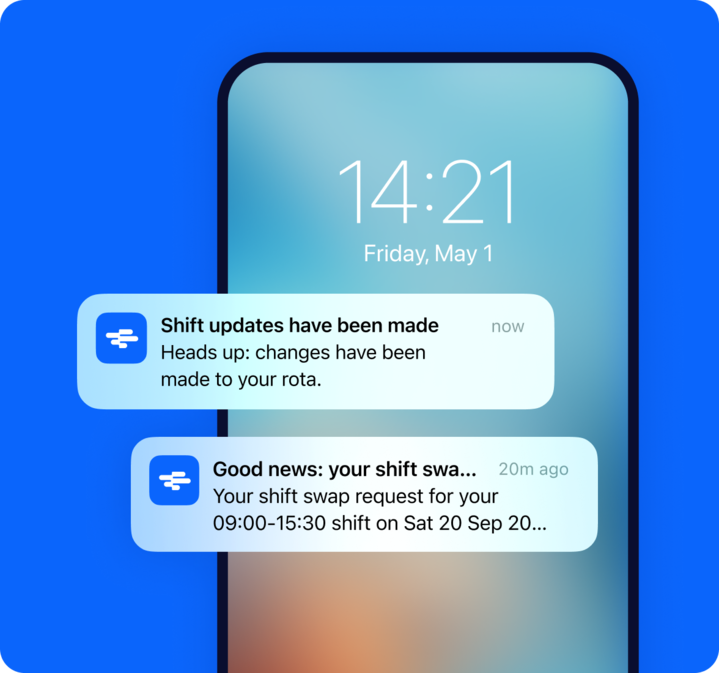You put a LOT of time and effort into planning your shift rota. The last thing you want is for your employees to start swapping shifts willy-nilly, undoing all of your hard work.
But the truth is, by giving your staff a degree of control over their shifts and providing them with a streamlined method of proposing their own shift swaps... it can actually be better for your business.
Here’s how self-service shift swaps can make life easier for both you and your team (plus, we have some tips for getting shift swaps right).
The benefits of shift swaps
Tips for creating an effective shift swap process
Shift swapping in RotaCloud
FAQs
Shift swap meaning
A shift swap or a 'shift swapping schedule' is when a pair of employees agree either to exchange shifts (each working the other’s shift) or one employee agrees to take on their coworker’s shift (also known as 'shift cover') in addition to working their own.
The benefits of shift swaps
For a lot of managers, the thought of staff swapping shifts in this way can be a bit daunting, since it can feel like you're losing a degree of control over your schedule.
Done right, however, shift swaps can actually be beneficial to your business in a number of ways…
1. Less admin for you
When your staff have the freedom to organise their own shift swaps or even have a shift swapping schedule, it inevitably means less admin for you.
Rather than having staff come to you with a problem to solve (“I can’t make my Friday night shift”), they’re instead coming to you with a possible solution.
Allowing your staff to organise their own shift swaps also encourages them to take greater ownership of their shifts since the onus is now on the employee to organise cover if they can’t work.
2. Happier staff
When staff have more freedom over the shifts they work, it can help them to better prioritise both their physical and mental health, reducing the impact that shift work can have on them over time.
It also demonstrates that you trust your staff, giving them a say in the shifts they work and allowing them to propose alternatives when the need arises.
3. Reduced employee turnover
Data shows that happier staff stick around for longer. That’s obviously good news for you as an employer since, as well as boosting morale and productivity at your business, fewer staff will hand in their notice in the long run.
This, in turn, means that you’ll spend less on recruitment and training (both of which can be expensive and time-consuming), allowing you to stay focused on running your business.
Tips for creating an effective shift swap process

So, you’ve decided to let your staff swap and cover one another’s shifts. But how do you actually go about doing so without shift swaps messing up your rota?
Here’s our simple guide to rolling out shift swaps at your business.
1. Set some rules for requesting shift swaps
Before making shift swaps part of your business, it’s important to set some criteria around the processes involved.
Some things you might consider for your shift swapping schedules:
- Who can (and can’t) swap shifts.
Can employees provide cover for each other regardless of their role? Can managers work shifts originally intended for regular staff? Is there a limit to the number of times an employee can swap shifts in a single pay period? - How to request swaps.
Your staff need to know how to request a shift swap, whether it’s by speaking to their manager in person, completing a shift swap request form, or perhaps through a digital scheduling system like RotaCloud. (We’ll talk more about these methods below.) - Deadlines for shift swap requests.
Ideally, you want to avoid staff swapping shifts at the last moment since this can disrupt your business. Try to set a cut-off point for when swaps will be considered so that you have time to update your rota if you give them the go-ahead. - Who will approve shift swaps?
The onus is on employees to propose swaps that work for everyone, but only specific members of your management team must have the power to approve shift swap requests – and who will be responsible for updating the rota accordingly.
The exact rules you create will depend largely on the industry you work in, the types of shifts you plan, and the roles that your employees work. Even so, it’s worth establishing some ground rules right off the bat so that everyone is clear on what they can and can’t do regarding shifts.
2. Decide HOW staff will request a shift swap
When it comes to shift swapping schedules, it’s important to choose a single method and stick to it. If you don’t, things will get complicated fast.
We’ve broken down some of the most common methods of organising and requesting shift swaps below, discussing the pros and cons of each, to help you decide the right process for your business.
In person
The most informal method for organising shift swaps is for your employees to discuss and agree a swap between them, then come to you in person to ask for the go-ahead.
✅ Pros
- Zero paperwork involved
- Friendly and informal
❌ Cons
- Can take time if all three parties don’t all work at the same time
- Requests can easily be forgotten about or dates mixed up
- Requires you to manually update the rota if the swap is approved
Work WhatsApp group
It’s becoming increasingly common for teams and workplaces to have dedicated WhatsApp groups used for things like shift updates and work-related chat. This can also be used by employees organising or asking permission to swap shifts.
✅ Pros
- Easily accessible
- Free to use
❌ Cons
- Group chats can quickly become chaotic, with key info easy to miss
- Frequent notifications may annoy other employees
- Staff may not want other team members to know their business
Shift swap request form
Many businesses choose to document shift swaps on paper, asking staff to fill out a form with the details of their proposed swap before giving it to a manager for approval.
✅ Pros
- Cheap and easy to manage
- Clear paper-trail avoids miscommunication
❌ Cons
- A slower process — it must be completed and handed to a manager in person
- Completed forms sometimes get lost or forgotten about
- More paperwork and admin for you and your team
Staff scheduling software
Advanced staff scheduling and workforce management software like RotaCloud has built-in shift swap features (along with many other self-service tools), allowing staff to organise and request swaps and cover via an app.
✅ Pros
- Very little admin for managers
- Self-service: staff take the initiative to solve the problem
- Staff know immediately if their swap has been approved
❌ Cons
- Requires a subscription to a staff scheduling software provider
The method you choose will depend on a number of factors, such as the number of people you have on your team and how often you envisage them asking to swap shifts.
Although it can be tempting to opt for methods like pen-and-paper and manual spreadsheets due to their relative affordability, keep in mind the additional admin (and, in turn, the hidden costs) that these processes require. Your time is valuable, after all. So, in many instances, a paid solution may be the more financially viable option.

3. Document your shift swap policy (and keep it accessible)
Now that you’ve decided on your shift swap policy and how employees will organise and propose shift swaps, the next step is to put it all in writing and share it with your team.
Try to keep this document brief (you want your employees to actually read this, after all!), but clear enough that nothing is left open to misinterpretation.
Finally, be sure to store this policy doc somewhere that your team can access even when you’re not available to ask. Sending the document out as a company memo or email is fine, but it’s often better to store your documentation online so that employees can quickly access it when they need to.
All that remains now is to roll out your shift swap policy and invite your team to use it.
Any new process can seem daunting at first. But keep in mind that, once your team become accustomed to it and get into a habit of organising their own shift swaps, your own rota-related admin should quickly start to decrease.
Your team will also enjoy the additional freedom that shift swaps can bring, allowing them to take on shifts that work for them — as well as trade those that don’t.
Shift swaps made simple with RotaCloud
RotaCloud is workforce management software that lets managers plan and share rotas, record staff attendance, and manage annual leave — all in one place.
It comes with a shift swap tool built in for those who need it, allowing staff to organise shift swaps between them through the RotaCloud mobile app, before sending them over to their manager for approval.

How it works: An example of a shift swap
- (Providing that shift swapping has been enabled by their manager,) When an employee has a shift that they can’t work, they simply tap the shift in their RotaCloud app to bring up the shift information sheet, then the blue button labelled ‘Request shift swap’.
(They can then choose a fellow employee to ask to take their shift, as well as offer to cover one of their shifts in return.) - Once they have, the shift swap request is sent to the second employee, who receives a notification via their phone and can either accept or decline the offer to swap shifts.
- If both parties agree to the swap, the request is automatically sent to their rota manager as a notification in their RotaCloud account.
- The manager can process the request via either the web or mobile version of RotaCloud and can approve or deny it with a click (or tap). If it’s the former, RotaCloud will automatically update the rota to reflect the new arrangement, with the change visible to everyone on the team.
- Done!
Wrap-up
Letting your team swap shifts needn't be scary. In fact, with a proper shift swap policy in place, it can quickly reduce your own administrative load and help your staff take greater control of their work-lives.
After creating a policy that takes your business' staff and push-and-pull factors into account, it's important to choose a single method for your staff to propose shift swaps when they need to.
Old-school methods like shift swap request forms and email can be a cheap way of organising swaps at your business, but can often result in additional paperwork for you as a manager - and cost you more in time, amends, and money as a result.
Instead, consider choosing staff scheduling software that comes with shift swap tools baked into it. This will allow your team to organise swaps with minimal effort, sending them directly to you for quick and easy review.
Online rota software
Reclaim your workday with RotaCloud
Plan rotas, record attendance, and manage annual leave in minutes with RotaCloud.
- 30-day free trial
- No card required
Read next ➤

The power of self-service tools
How can self-service tools help streamline your staff scheduling process? From shift swaps to leave requests to availability, learn how having your team's input can help cut back your admin (plus MANY other benefits).
Editor's Note: This post was originally published in October 2023 and updated for accuracy in October 2025.
Frequently asked questions
Why do people swap shifts?
Life happens. Things pop up, like childcare or wanting a certain night free. Staff can find themselves no longer able to work the shift they've been assigned, or couldn't to begin with, or would simply prefer another. A shift swapping schedule gives staff the freedom to discuss potential swaps with colleagues and arrange them themselves, providing an extra level of flexibility and control around when they work.
Are employees allowed to swap shifts?
Yes. Though, it's down to the employer to implement it and have a policy for it. Doing so gives staff more autonomy over when they work and, if using a self-service staff scheduling or shift swap app, can take all the admin strain from the manager.
What is an example of a shift swap?
Emma has a Thursday 12:00 - 20:00 shift.
Alex has the 06:00 - 14:00 Thursday shift.
Due to a change in circumstances, Emma now needs to pick her kids up from school, so asks Alex if they would mind swapping shifts.
Alex doesn't mind, and would quite like the lie-in, so is happy to swap.
They take this to their manager, who approves it and updates the rota. A simple switch!
Can you shift swap during peak seasons?
Technically, yes. Though, it's down to the employer and their shift swap policy for any restrictions or deadlines for swap requests. If using a self-service scheduling app like RotaCloud, where staff can arrange shift swaps themselves for the manager to approve or deny, it should do very little to impact your peak seasons.



